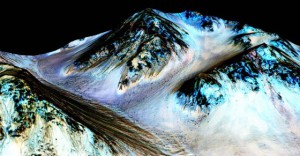PARIS: Scientists on Monday announced “the strongest evidence yet” of liquid water on Mars, raising the distant prospect of microscopic life on the Red Planet.
“Mars is not the dry, arid planet we thought of in the past,” Jim Green, NASA’s planetary science director, told journalists in Washington. “Under certain circumstances, liquid water has been found on Mars.”
In a research paper published in the journal Nature Geoscience, a team of experts said curious lines running down steep slopes on the surface of the Red Planet might be streaks of super-salty brine.
The presence of hydrated salt minerals in the lines indicates that “water plays a vital role in the formation of these streaks,” according to Lujendra Ojha of the Georgia Institute of Technology in Atlanta, who co-authored the study.
NASA said the findings “provide the strongest evidence yet that liquid water flows intermittently on present-day Mars” and could make it easier to send a manned mission to the planet, which it aims to do in the 2030s.
“To be able to live on the surface, the resources are there,” said astronaut John Grunsfeld, who is also associate administrator of NASA’s science mission directorate.
The salt minerals, called perchlorates, contain water molecules in their make-up.
If anything, it was likely “wet soil, not free water sitting on the surface,” study co-author Alfred McEwen from the University of Arizona, told AFP.
It is widely accepted that the Red Planet once hosted plentiful water in liquid form, and still has water today, albeit frozen in ice underground.
Earlier this year, NASA said almost half of Mars’ northern hemisphere had once been an ocean, reaching depths greater than 1.6 kilometers.
Astrobiologist Lewis Dartnell of the University of Leicester Space Research Center said the study, which he did not take part in, presented “very strong evidence that what we believe to be signs of liquid water trickling down the Martian surface is in fact that.”
This, in turn, raised the intriguing prospect of life, he told AFP.
“If there is liquid water trickling beneath the surface, maybe that’s an environment where bacteria and microbial life can survive . . . The results we’ve had this afternoon are very exciting because they increase the possibility that there is life alive on Mars today.”
AFP


